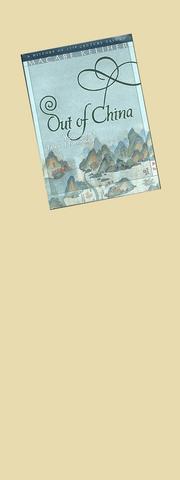Taiwan at the close of the 17th century was a place that existed on the razor edge of anarchy. "This is not a place for humans," was how Yu Yonghe, a scholar and adventurer who traveled to the island in 1697, summed up the land.
Yu made the comment in his diary while in Taiwan on temporary assignment from the Fujian provincial administration to extract sulphur from the hills above Tamsui. The diary of his expedition is the basis for a new book titled Out of China by Macabe Keliher.
Part travelogue and part history, this book sheds some light on a period in Taiwan's early settlement that few have bothered to write about in English. Starting from a personal account of Taiwan in that period, Keliher writes from a perspective that is fresh and eminently readable, though frustratingly limited in scope.

The story follows Yu, whose lust for adventure makes him a curious anomaly among China's notoriously timid literati, as he travels south through Fujian to Xiamen, across the strait and then by land from Taiwan Fu, now known as Tainan, north to Tamsui.
To read Yu's story it's easy to understand why he would describe the island as practically uninhabitable for its Chinese residents. Violent death was an all too typical fate for migrants to Taiwan. A huge proportion of people either drowned on the way there, or were felled by some horrible disease or the island's vicious flora and fauna not long after arriving.
As if succumbing to the forces of nature wasn't bad enough, there were the Aborigines who periodically raided villages or ambushed hapless travelers, carrying off the victims' heads and limbs as trophies.
Indeed, detailing the dangers associated with traveling to and living on Taiwan seem to form the bulk of Yu's diary. Whether this is Keliher's edit or the full content of the diary is not made clear. It does, however, leave the distinct impression that only the brave or foolhardy had the gusto to come to Taiwan during that era.
Yu's diary entries are rarely over a few paragraphs long, which would indicate that he was not an especially prolific writer. His observations are sufficient, though, to discern the perspective of Qing dynasty scholars toward this "mud ball in the sea," as the emperor Kangxi labeled Taiwan.
He admired the tenacity and ingenuity of the settlers and noted that a large number of them were running from the law. In actuality, the majority came to this frontier island in hopes of securing a plot of its fertile soil, because population pressures in China at the time were driving peasants to starvation.
Yu also frequently turns his attention to descriptions of the Aborigines with whom he interacted during his journey. He is ashamed of their nakedness and frowns upon their cavalier attitude toward sex. On several occasions he writes of the need to impart education and "civilization" upon the Aborigines to, in effect,
Sinicize them.
Despite such imperialistic prejudice, Yu in the same breath expresses genuine awe at the ways in which the Aborigines have adapted to the harsh environment. As for himself, Yu is clearly mortally afraid of the Aborigines, perhaps even more frightened than he is of the natural elements, as he bungles from one near-disaster to the next during his trip.
To add some meat to the rather meager bones of Yu's diary, Keliher intersperses the book with chapters that provide some much-needed historical context. Together these sections form an abridged version of Taiwan's 17th-century history that will be fascinating reading for someone interested in the island's past, but who isn't fussed about too many details.
In these sections, Keliher has dug up some intriguing references to Taiwan from Ming and Qing dynasty officials that answer a few questions about the island's relationship to continental China.
The Ming wanted nothing to do with the island and the Qing was equally reluctant to take it on as a colony. The only reason the Qing came to Taiwan in the first place was to finish off the remnants of the Ming who had sought refuge on the island and set up a breakaway kingdom. Court officials remarked that Taiwan "has never been a part of Chinese territory" and said that to occupy and administer the island would be a waste of resources, though ultimately the Qing did bring Taiwan into its administrative fold.
Out of China is often an
exciting account of travel to this far-off and danger-filled island. But Yu's diary is short on details that would offer a more complete sense of what life was like in Taiwan during that time. We never know, for example, what sort of town Tainan was at the time, what people ate, wore, or what dialects they spoke. Yu rarely comments on population numbers in the towns and villages he passes, and never identifies the Aborigine tribes by name.
Yu himself is also something of an enigma. We never learn why and how the Qing government entrusted someone who was not an official with the task of overseeing the procurement of vital resources. These may have been conscious ommissions on Keliher's part, but the unfortunate result is that too many obvious questions remain unanswered at the end of Yu's tale. This and the annoying frequency of printing errors detract from an otherwise fascinating story.

April 14 to April 20 In March 1947, Sising Katadrepan urged the government to drop the “high mountain people” (高山族) designation for Indigenous Taiwanese and refer to them as “Taiwan people” (台灣族). He considered the term derogatory, arguing that it made them sound like animals. The Taiwan Provincial Government agreed to stop using the term, stating that Indigenous Taiwanese suffered all sorts of discrimination and oppression under the Japanese and were forced to live in the mountains as outsiders to society. Now, under the new regime, they would be seen as equals, thus they should be henceforth

Last week, the the National Immigration Agency (NIA) told the legislature that more than 10,000 naturalized Taiwanese citizens from the People’s Republic of China (PRC) risked having their citizenship revoked if they failed to provide proof that they had renounced their Chinese household registration within the next three months. Renunciation is required under the Act Governing Relations Between the People of the Taiwan Area and the Mainland Area (臺灣地區與大陸地區人民關係條例), as amended in 2004, though it was only a legal requirement after 2000. Prior to that, it had been only an administrative requirement since the Nationality Act (國籍法) was established in

Three big changes have transformed the landscape of Taiwan’s local patronage factions: Increasing Democratic Progressive Party (DPP) involvement, rising new factions and the Chinese Nationalist Party’s (KMT) significantly weakened control. GREEN FACTIONS It is said that “south of the Zhuoshui River (濁水溪), there is no blue-green divide,” meaning that from Yunlin County south there is no difference between KMT and DPP politicians. This is not always true, but there is more than a grain of truth to it. Traditionally, DPP factions are viewed as national entities, with their primary function to secure plum positions in the party and government. This is not unusual

The other day, a friend decided to playfully name our individual roles within the group: planner, emotional support, and so on. I was the fault-finder — or, as she put it, “the grumpy teenager” — who points out problems, but doesn’t suggest alternatives. She was only kidding around, but she struck at an insecurity I have: that I’m unacceptably, intolerably negative. My first instinct is to stress-test ideas for potential flaws. This critical tendency serves me well professionally, and feels true to who I am. If I don’t enjoy a film, for example, I don’t swallow my opinion. But I sometimes worry